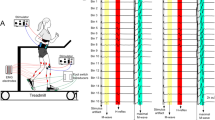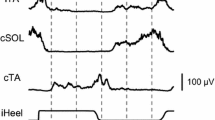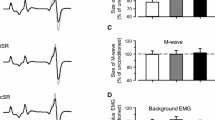Summary
Hoffmann (H) reflexes were elicited from the soleus (SOL) muscle while subjects walked on a treadmill and on a narrow beam (3.5 cm wide, raised 34 cm from the floor). The speed of walking on the treadmill was selected for each subject to match the background activation level of their SOL muscle during beam walking. The normal reciprocal activation pattern of the tibialis anterior and SOL muscles in treadmill walking was replaced by a pattern dominated by co-contraction on the beam. In addition, the step cycle duration was more variable and the time spent in the swing phase was reduced on the beam. The H-reflexes were highly modulated in both tasks, the amplitude being high in the stance phase and low in the swing phase. The H-reflex amplitude was on average 40% lower during beam walking than treadmill walking. The relationship between the H-reflex amplitude and the SOL EMG level was quantified by a regression line relating the two variables. The slope of this line was on average 41% lower in beam walking than treadmill walking. The lower H-reflex gain observed in this study and the high level of fusimotor drive observed in cats performing similar tasks suggest that the two mechanisms which control the excitability of this reflex pathway (i.e. fusimotor action and control of transmission at the muscle spindle to motoneuron synapse) may be controlled independently.
Similar content being viewed by others
References
Akazawa K, Aldridge JW, Steeves JD, Stein RB (1982) Modulation of stretch reflexes during locomotion in the mesencephalic cat. J Physiol (Lond) 329: 553–567
Baldissera F, Hultborn H, Illert M (1981) Integration in spinal neuronal systems. In: Brooks VB (eds) Handbook of physiology, Sect I, Vol II. Motor control, Part I. American Physiological Society, Bethesda, pp 509–595
Buchthal F, Schmalbruch H (1970) Contraction times of twitches evoked by H-reflexes. Acta Physiol Scand 80: 378–382
Burke RE (1968) Group Ia synaptic input to fast and slow twitch motor units of cat triceps surae. J Physiol (Lond) 196: 605–630
Capaday C, Stein RB (1986) Amplitude modulation of the soleus H-reflex in the human during walking and standing. J Neurosci 6: 1308–1313
Capaday C, Stein RB (1987) Difference in the amplitude of the human soleus H reflex during walking and running. J Physiol (Lond) 392: 513–522
Collins WF III, Honig MG, Mendell LM (1984) Heterogeneity of group Ia synapses on homonymous α-motoneurons as revealed by high-frequency stimulation of Ia afferent fibers. J Neurophysiol 52: 980–993
Crenna P, Frigo C (1987) Excitability of soleus H-reflex arc during walking and stepping in man. Exp Brain Res 66: 49–60
Crone C, Nielsen J (1989) Spinal mechanisms in man contributing to reciprocal inhibition during voluntary dorsiflexion of the foot. J Physiol (Lond) 416: 255–272
Cussons PD, Matthews PBC, Muir RB (1980) Enhancement by agonist or antagonist muscle vibration of tremor at the elastically loaded human elbow. J Physiol (Lond) 302: 443–461
Dunbar DC, Horak FB, MacPherson JM, Rushmer DS (1986) Neural control of quadrupedal and bipedal stance: implications for the evolution of erect posture. Am J Phys Anthropol 69: 93–105
Eccles JC, Fatt P, Landgren S (1956) Central pathway for direct inhibitory action of impulses in largest afferent nerve fibres to muscle. J Neurophysiol 19: 75–98
Garrett M, Luckwill RG, McAleer JJA (1981) The sensitivity of the monosynaptic reflex arc in the leg extensor muscles of the walking man. In: Morecki A, Fidelus K, Kedzior K, Wit A (eds) Biomechanics VIIA. University Park Press, Baltimore, pp 95–99
Honig MG, Collins WF III, Mendell LM (1983) α-motoneuron EPSPs exhibit different frequency sensitivities to single Ia-afferent fiber stimulation. J Neurophysiol 49: 886–901
Hugon M (1973) Methodology of the Hoffmann reflex in man. In: Desmedt JE (eds) New developments in electromyography and clinical neurophysiology, Vol 3. Karger, Basel, pp 277–293
Hulliger M, Horber F, Medved A, Prochazka A (1987) An experimental simulation method for iterative and interactive reconstruction of unknown (fusimotor) inputs contributing to known (spindle afferent) responses. J Neurosci Meth 21: 225–238
Jacks A, Prochazka A, Trend PStJ (1988) Instability in human forearm movements studied with feedback-controlled electrical stimulation of muscles. J Physiol (Lond) 402: 443–461
Lippold OCJ, Redfearn JWT, Vuco J (1957) The rhythmical activity of groups of motor units in the voluntary contraction of muscle. J Physiol (Lond) 137: 473–487
Llewellyn M, Prochazka A, Vincent S (1987) Transmission of human tendon jerk reflexes during stance and gait. J Physiol (Lond) 382: 83P
Llewellyn M, Prochazka A, Yang JF (1989) Human H-reflexes are reduced in difficult beam-walking compared to stance and normal walking. J Physiol (Lond) 418: 104P
Mark RF, Coquery J-M, Paillard J (1968) Autogenetic reflex effects of slow or steady stretch of the calf muscles in man. Exp Brain Res 6: 130–145
Mizuno Y, Tanaka R, Yanagisawa N (1971) Reciprocal group I inhibition on triceps surae motoneurons in man. J Neurophysiol 34: 1010–1017
Prochazka A (1989) Sensorimotor gain control: a basic strategy of motor systems? Prog Neurobiol 33: 281–307
Prochazka A, Hulliger M, Trend P, Durmuller N (1988) Dynamic and static fusimotor set in various behavioural contexts. In: Hnik T, Soukup R, Vejsada R, Zelena J (eds) Mechanoreceptors: development, structure and function. Plenum Press, London, pp 417–430
Prochazka A, Westerman RA, Ziccone SP (1976) Discharges of single hindlimb afferents in the freely moving cat. J Neurophysiol 39: 1090–1104
Rack PMH, Ross HF, Thilmann AL (1984) The ankle stretch reflexes in normal and spastic subjects. Brain 107: 637–654
Schieppati M (1987) The Hoffmann reflex: a means of assessing spinal reflex excitability and its descending control in man. Progr Neurobiol 28: 345–376
Stein RB, Capaday C (1987) The modulation of human reflexes during functional motor tasks. Trends Neurosci 11: 328–332
Stein RB, Lee RG (1981) Tremor and clonus. In: Handbook of physiology, Sect I, Vol II, Part I. American Physiological Society, Bethesda, pp 325–344
Vallbo AB (1974) Human muscle spindle discharge during isometric voluntary contractions: amplitude relations between spindle frequency and torque. Acta Physiol Scand 90: 319–336
Weiss PL, Kearney RE, Hunter IW (1986) Position dependence of stretch reflex dynamics at the human ankle. Exp Brain Res 63: 49–59
Author information
Authors and Affiliations
Rights and permissions
About this article
Cite this article
Llewellyn, M., Yang, J.F. & Prochazka, A. Human H-reflexes are smaller in difficult beam walking than in normal treadmill walking. Exp Brain Res 83, 22–28 (1990). https://doi.org/10.1007/BF00232189
Received:
Accepted:
Issue Date:
DOI: https://doi.org/10.1007/BF00232189




